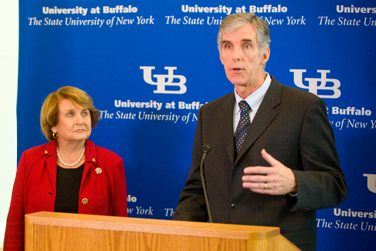News
UB to receive millions for cyclotron

UB Distinguished Professor Timothy Murphy speaks at a press conference during which Rep. Louise Slaughter announced UB’s receipt of a $4.6 million federal appropriation to purchase a cyclotron. Photo: DOUGLAS LEVERE
-
 Print
Print -
 Comments
(2)
Comments
(2)
-
Multimedia
Cyclotron to enhance medical research. Watch a video.
Rep. Louise M. Slaughter today announced a $4.6 million appropriation from the U.S. Department of Defense to UB to purchase a cyclotron to support the university’s $118 million Clinical and Translational Research Center (CTRC).
UB’s CTRC and Biosciences Incubator are under construction on the Buffalo Niagara Medical Campus. These facilities will join Kaleida Health’s Global Vascular Institute in a new combined $291 million 10-story clinical care, clinical and translational research, and business incubation building to be located next to Buffalo General Hospital at Goodrich and Ellicott streets.
The CTRC will expand UB’s focus on translating basic medical research into new treatments and technologies made available for patients. The Biosciences Incubator will provide laboratories, office space and start-up services to companies spun off from UB medical discoveries. UB’s incubator is expected to be at full occupancy after two to three years, with 130 employees. According to studies on the economic effect of biomedicine and biotechnology research, the UB CTRC and Biosciences Incubator are projected to produce an annual economic impact of $68 million.
The PETrace cyclotron is an essential research device expected to lead to the development of new therapies and treatments, particularly for cardiovascular diseases, cancer and neurological disorders. The cyclotron will generate radiopharmaceuticals essential for supporting molecular imaging with positron emission tomography (PET), a technology that holds great promise for understanding mechanisms of disease.
The UB cyclotron will provide researchers throughout the Buffalo Niagara Medical Campus, including those at Roswell Park Cancer Institute, the capability of performing state-of-the-art molecular scanning.
“The Buffalo Niagara Medical Campus has been an anchor of job creation and innovation for Buffalo which is why I’m so pleased to announce this funding for the purchase of a cyclotron at the University at Buffalo,” said Slaughter. “With this funding, the Clinical and Translational Research Center on the Buffalo Niagara Medical Campus will have the ability to develop new therapies and treatments for cardiovascular diseases, cancer and neurological disorders, and makes UB more competitive for federal research grants to continue their lifesaving work.”
The cyclotron will be housed in the lower level of the UB-Kaleida Health building, which is scheduled to open in fall 2011. UB’s CTRC and Biosciences Incubator will occupy the building’s fifth to eighth floors, with the lower four floors housing Kaleida Health’s Global Vascular Institute.
The building has been designed with 4,000 square feet of space in the basement dedicated specifically for the UB cyclotron. Installation is scheduled for summer 2011.
UB Distinguished Professor Timothy F. Murphy, senior associate dean for clinical and translational research in the School of Medicine and Biomedical Sciences, said the cyclotron will be the only one on the Buffalo Niagara Medical Campus and will be the foundation of a cutting-edge imaging facility at UB.
“Having the state-of-the-art cyclotron will provide a major boost to our Clinical and Translational Science Award (CTSA) application to the NIH, which we submitted this month,” said Murphy. “The UB CTRC will be the hub of the Buffalo Translational Consortium, which includes 11 member institutions and four community partners.
“CTSAs are large infrastructure grants intended to reduce interdisciplinary and inter-institutional barriers to perform outstanding clinical and translational research. Working as a consortium will allow us to develop new diagnostic, treatment and prevention strategies to improve the health of the community and the nation.
“This cyclotron will allow UB researchers and our colleagues throughout the Buffalo Niagara Medical Campus to perform groundbreaking research in a broad range of disorders, including cardiovascular disease, cancer and neurological diseases such as stroke, multiple sclerosis and dementia,” Murphy said.
He noted that given the priority placed on studies of traumatic brain injury and neuropsychiatric disorders by the Department of Defense in military personnel returning from combat, state-of-the-art neuroimaging capability will well position investigators at UB to advance this critical field of research.
Molecular scanning with PET scanners will advance research in cancer by detecting early cancers that other scanning techniques cannot. PET scans reveal functional and metabolic activity in early cancers, while other types of scans reveal anatomic images only. This capability expands the research potential on many types of cancer.
Molecular scanning has revolutionized research in neurological disorders. PET scans can be used to measure various types of metabolic activity in different parts of the brain, such as uptake of glucose.
Radioactive isotopes injected into the body during scanning provide information about the functioning of a person’s specific organs or to treat disease. Using these isotopes, nuclear medicine imaging produces three-dimensional, color images of functional processes in the human body. The information can be used by researchers to investigate new ways to treat disease and by physicians to make a quick, accurate diagnosis of a patient’s illness.

Reader Comments
Rebecca Goodman says:
This university "forgets" it already has a cyclotron facility. UB possesses a 30 MeV negative ion cyclotron capable of delivering 550 µA on target. (Typically, most PET facilities have 11–18 MeV accelerators.) PET technology for "groundbreaking research" has been available in Western New York since 1992.
Posted by Rebecca Goodman, Program Administrator, 11/03/10
Alan Haungs says:
What will happen to the existing cyclotron on the south campus of UB?
Posted by Alan Haungs, Masters Electrical Engineering Student at UB, 10/30/10